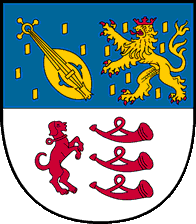Tour of Spiesheim’s History
The Protestant Church
 1898 Protestant Church - colorized postcard
1898 Protestant Church - colorized postcard
In 1246, a "church at Spiesheim" was mentioned for the first time when Pope Innocent IV sanctioned the passing of the right of patronage on to the Convent of Cistercian nuns Sion near Mauchenheim. At that time, it was only Catholicism and the Catholic Church that existed in Spiesheim. The latter has been consecrated to St. Stephen.
In 1556, Count Palatinate Ottheinrich introduced the Reformation in the superior bailiwick of Alzey. The "Religious Peace of Augsburg" concluded in 1555 granted the sovereign the right to define the religion of his subjects: "cuius regio, eius religio". Most of the inhabitants of Spiesheim bowed to this principle, so that exclusively Reformed (today "Protestant") services after Calvin's doctrine were held in the church that had been catholic so far. It was only in 1698 when the then Catholic Count Palatinate Johann Wilhelm Ignatius ordered by edict that the Reformed had to open their church to the Catholics, too, so that the church was used as a double church, which soon set the two confessions against each other. Nevertheless, the common use lasted until 1705 when through the "Schism of the Electoral Palatinate" the Catholic Church was granted custody of the church for their exclusive right to use it.
So the Reformed (Protestant) community was forced to erect its own church. They bought an old barn at the opposite of the Catholic Church and the adjoining Liding and fitted it out as place of worship. In view of the great number of members this room became too small after a few years and rapidly decayed. In 1755, the community acquired an area at "Auf dem Backesgarten", which is right here, to build a new and larger church.
Furthermore, a new schoolhouse and an apartment for the teacher were planned to be built next to the new church. These were the ideas and plans of the community which could not be realised at once due to lack of money. After 30 years of collecting money, the church administration allowed to ask communities even in the region of Palatinate for help to be able to build this church. In June 1788, when the plans were finished, master bricklayer Heinrich from Heimersheim received the order to build the foundations by August 1789, which he did. Unfortunately, works had to be stopped again due to lack of money for the church, which was described as an "excessively large building" for that time.
Moreover, the global situation was very uncertain. The French Revolution had begun which led to the fact that our region became French and, furthermore, the role of religion decreased considerably. Some of the reasons that hindered the community to continue the construction of their church 5 decades long were two wars following the Revolution and the integration of Rhine Hesse into the Grand Duchy Hesse-Darmstadt. In the meantime, the old barn church at Liding had to be closed in 1800 due to dilapidation. The organ made by Stumm was installed in the Protestant school and the bell from 1728 was hung in the steeple of the Catholic Church. Being without a church now, the Reformed community of Spiesheim had to attend the services in Armsheim, as they belonged administratively to that parish. In 1822, Reformed united with Lutherans to form the Rhine Hessian Protestant Church and in 1824, Spiesheim became a daughter church of the parish Ensheim. Gradually, more peaceful times came back.
In 1843, after many presentations at the church administration in Darmstadt, an agreement was found about the draft of the then famous architect and "Court Building Director" Georg Moller who planned 16 territorial churches in South Hesse during that era.
In spring 1844, the new church was erected on the 55-year-old foundations.
Grand ducal master builder Rhumbler of the district Alzey supervised the works of the craftsmen coming mostly from the proximity.
At the same time, the old barn church was torn down and the estate and timber auctioned. A great deal of the old stones could be used in the construction of the new church but a considerable bulk of stones was brought along from the quarries in Bornheim and Flonheim by the community members.
A beautiful light church in Byzantine style arose.
A hall with a moderately ascending roof and three-sided galleries at the longitudinal walls and entrance front is built on a rectangular ground plan. The entrance towards West contains a rosette-shaped window made of rich decorated cast iron over the portal.
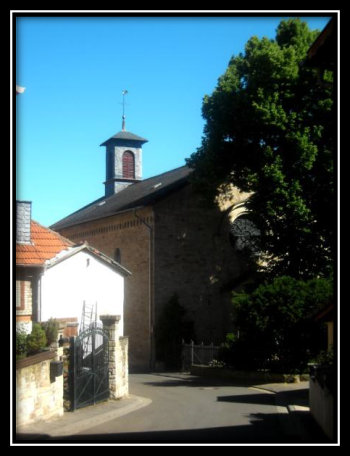
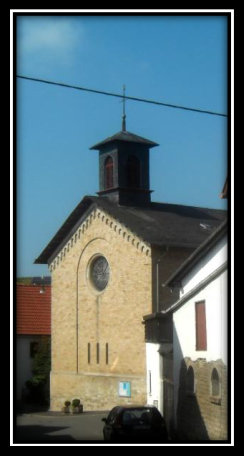
This church does not have a bell tower but only a roof turret carrying the two bells. On the right hand of the entrance with a small porch, stairs lead to the galleries carried by slender columns in Byzantine style. The columns divide the hall into one inner room in the centre with firmly anchored bench rows and two lateral rooms where chairs can be arranged if necessary. Each of the side walls is structured by 5 windows. The altar at the narrow side towards East stands free in front of a smaller column carrying the pulpit fixed at the wall. The gallery with the organ above the pulpit is lighted by a large round rosette-shaped window made of cast iron. The whole side ends with an arch over the organ. The separated side rooms, sacristy and verger's room, are situated behind the nave. The wall separating them is divided by two combinations of door and window in round-arch style arranged symmetrically at the sides of the altar. The only usable door leads to the sacristy on the left of the altar. From the sacristy, stairs go up to pulpit and organ gallery and down to the back door.

After thorough renovation the precious Stumm organ that had been stored was put into service again and the bell that had been used in the Catholic Church was installed in the roof turret of the Protestant Church. Additionally, a new, larger bell was bought with the help of the then Gustav Adolf Society. On January 6, 1846, the new church was opened after 22 months of construction time and consecrated by superintendent Nonnweiler in a solemn service accompanied by the first choir of Spiesheim on May 4, 1846.
The first extensive renovation of the church was made in 1911/1912. Among other things to be done a new ceiling was installed.
During World War I and II many communities in Germany had to hand over church bells and organ pipes made of tin to the government so that war material like bombs, grenades, rifles etc. could be produced. Both the Protestant and the Catholic Church of Spiesheim had to give a bell and all tinned organ pipes.
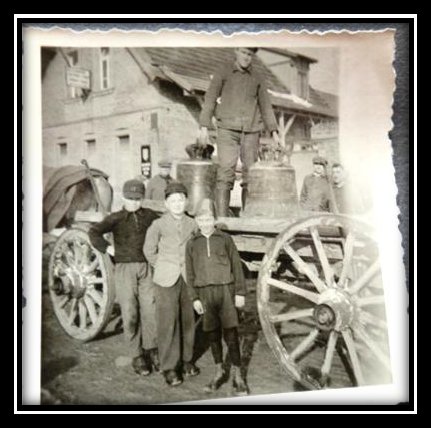
March 9, 1942 - Departure of Church bells in Spiesheim
After the wars: Thanks to generous donations of Wilhelm Jung and his wife Anna, born Dexheimer, who had emigrated to New York, a new bell and new organ pipes could already be acquired shortly after World War I in 1921/1922. Furthermore, donations were sufficient for a cobble-stone-paved path from the street to the church portal. After World War II, Jakob and Katharina Margarethe Diefenthäler also donated a new bell with the inscription "Glaubet Ihr nicht, so bleibet Ihr nicht" (Isaiah 7:9) that was consecrated on July 26, 1959.
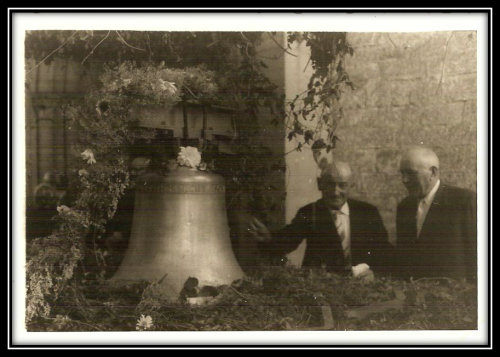 July 26, 1959 - Consecration of the new bell
July 26, 1959 - Consecration of the new bell
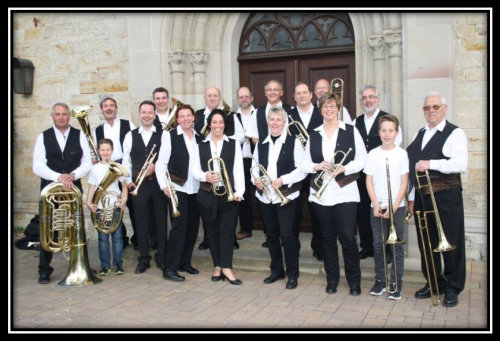 Protestant Trombone Choir Spiesheim in 2012
Protestant Trombone Choir Spiesheim in 2012
Since 1962, there has been a trombone choir in the Protestant community that accompanies the services of the highest religious holydays as well as it musically supports social welfare work in the nearby old people's and nursing homes and hospitals in Alzey according to the general motto of all trombone choirs: "Our task is to praise God". To practice the central idea "To the honour of God and the joy of people" is a pleasure for the group. They also contribute to local events like annual fair, club events, birthdays and anniversaries of old people independent of confession or attitude, if this is desired and possible with regard to the schedule and personnel. As part of the Protestant community the trombone choir gives concerts once a year either in Advent or in spring or they take part in the organisation of concerts of other music ensembles in the church. The proceeds have always been donated to social institutions.
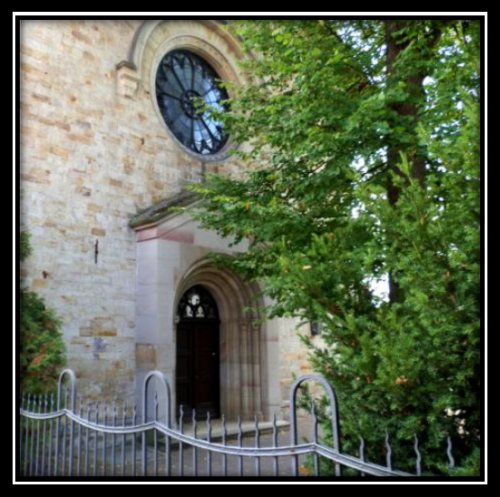
The church has been given its current appearance through the second extensive renovation of the interior from 1964 to 1967. Strictly corresponding to the conditions of the preservation of historical monuments the original appearance has been largely conserved. An electrical heating with tubes under the skirting of the bench rows was installed.
The continuing weathering of the outer walls made of "soft" sandstone from Flonheim caused an extensive and costly renovation from 1988 to 1989.
In 2005, 2 Communion cans from 1822, the year of the reunion of Reformed and Lutherans to the Rhine Hessian Church were found in an old unnoticed box in the timberwork, furthermore old bibles from 1703, 1894 and 1911, hymnbooks from 1916 and a church register from 1858. After a thorough restoration these objects have been exhibited in a special showcase at the entrance.
In 2008, the old electrical heating was renewed and provided with a computer-steered regulation. The heating tubes are installed under the seats of the bench rows and protected by grids. Thanks to the Catholic Church, services could be held there during the renovation.
Spiesheim was a daughter church of the parish Armsheim from 1688 on and of the parish Ensheim from 1824 on. Since January 1, 1999, the Protestant community of Spiesheim has belonged to the parish Bechtolsheim together with Biebelnheim and Ensheim, abbreviated BBES. All of them attempt to offer incentives for an active life in community, passionately supported by the current Protestant pastor Markus Krieger. So the parish newsletter "eBBES" was awarded in 2015. The parish is also represented on the Internet at www.e-bbes.de.
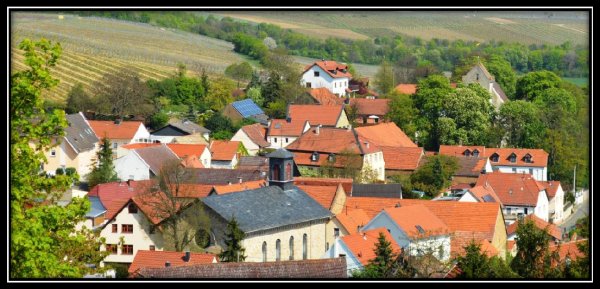 View of centre and old part of Spiesheim with Protestant Church
View of centre and old part of Spiesheim with Protestant Church
Text 11: Sigmund Jung
Translation: Hildegard Wingert
Pictures: Erich Dexheimer - Ebermeyer - Georg Wenicker -Wolfgang Steinmetz
October 2016
